Varieties of Rincón Three Reales of Mexico Charles-Joanna
by Cori Sedwick Downing
Some of the earliest coins struck at the Mexico City mint were the 3-reales denomination, under the first assayer Francisco del Rincón (hereafter Assayer R). We can establish a relative timeline for Assayer R coins by the analyzing the quantity of lettering that is Gothic compared to the later Latin lettering. Sometimes other elements, such as the use of native punches instead of original Spanish punch designs, give us additional timeline clues. As a result, there are three varieties of 3-reales
coins, in the following chronological order:
1. Coins with three dots for denomination and water running beneath the pillars (similar to but not the same as “pillars and waves” in later coinage)
2. Coins with three dots for denomination and no water
2b - Coins with three dots for denomination and no water with 3 dots/annulets variety
3. Coins with three bars for denomination and no water
There was some crossover of design from one variety to the next, and there was more than one design within each group.
By royal decree a quarter of the silver minted at the Mexico City mint was for 2- and 3-reales coins. Based on analysis of lettering, the 3-reales pieces were minted before 2-reales coins. The original decree mandated that 3 reales would be paid to mint officials for each mark of silver they coined (according to Nesmith, the actual payout was 68 maravedis, or 2 realesNesmith, Robert I., The Coinage of the First Mint of the Americas at Mexico City 1536-1572, NNM 131, American Numismatic Society, 1955, pp. 14, 13. Perhaps that is why the 3 reales were minted in the first place: regardless, they were quickly discontinued by royal fiat.
How We Study the Coins
Many different design elements differentiate one coin from another, We usually analyze both the shield side and the pillars side separately, but we can also compare a whole coin to others. Instead of using the terms obverse and reverse, we prefer to say shiels side and pillars side to avoid any confusion since there is a difference of opinion among munismatics as to which is the obverse and reverse.
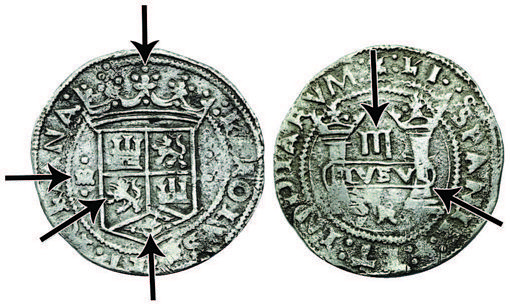
Shield-side elements we analyze are the following:
• Whether the lion in the shield has a tongue and a crown
• Whether the pomegranate at the bottom of the shield has leaves or dots on either side of it
• Whether the crown is contained within the beaded circle or outside of it
• Whether there are four or eleven rondules in the crown
• Whether the mint mark of “M” is Gothic or Latin
• Whether all, some, or none of the legend around the shield contains Gothic or Latin lettering
• What the legend spells out (particularly how the legend ends and what stops are used to separate words)
Pillars-side elements we analyze are the following:
• Whether there are three dots with water under the pillars, three dots and no water, or three bars for the denomination
• In which direction the ribboned banner runs
• What is contained within the banner (in the case of 3 reales, PLVSVL or PLVSVT)
• Whether all, some, or none of the legend around the pillars contains Gothic or Latin lettering
• What the legend spells out (particularly how the legend ends and what stops are used to separate words)
Varieties of Three Reales
Three Dots for Denomination with Water Under the Pillars
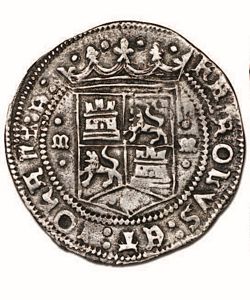
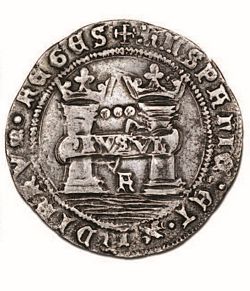
Lot 664. Sedwick Treasure Auction #24, November 2018 (three dots, with waves)
The design element of water running under pillars must have been short-lived, given the scarcity of known coins—just four in total. This is the only Early Series coinage with this design, while waves under the pillars was a hallmark of the Late Series designs as well as later designs at other New World mints. Interestingly, the sea is calm on 3 reales coins, while the Late Series coins display choppy waters. For whatever reason, this must not have been a popular issue and was probably soon replaced by the three-dots variety without water.
The banner that runs between and wraps around the outside of the pillars always contains PLVSVL within it (an abbreviation for PLVS VLTRA)It changes to PLVSVLT in the three-dots/no-water variety and reverts to PLVSVL in the three-bars variety.. The banner wraps around the pillars from lower on the left to higher on the right In the no-water type, the banner wraps in either direction. In the three-bars variety, the banner wraps in the same direction as the three-dots/water variety, with a Latin L instead of a Gothic L in PLVSVL..
There are two known shield-side designs for this type:
• those with the crown (which sits atop the lions-and-castles shield) contained within the beaded circle: thus a legend surrounds the entire coin, and
• those with the crown outside the beaded circle (the design for all other Charles and Joanna coins).
Again, there must have been some experimentation with this design since there is no other denomination— Early or Late Series—in which the crown is contained within the beaded circle.
Of the two known coins of the type where the crown is within the beaded circle, one displays a Gothic M mintmark on either side of the shield (the convention for coins of this period) and the other displays a Latin-M mintmark, as on the coin belowThis Latin mintmark also appears on two designs of the three-dots/no-water variety and was illustrated by Nesmith as his 5a variety. It is also interesting to note that one of those is a “crown within the beaded circle” design. Its shield side is a very close cousin, with the only discernible difference being “:” instead of “.” as a stop in the legend (all lettering is Gothic).. Within the shield, the lions have tongues and crowns and the pomegranates have leaves. There are four rondules above the crown. This is true of most of the other 3 reales.
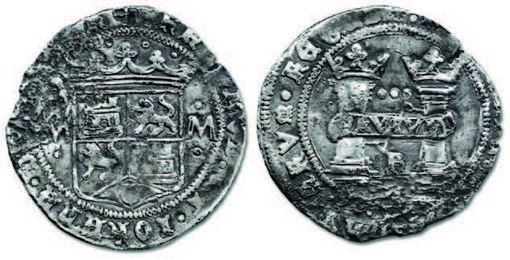
Of the second shield-side design – those with the crown outside the beaded circle – the lions in the shield are different, with a furry mane and no tongues or crowns (what Nesmith called a “native imitation”). They can be found on no-water 3 reales of the Nesmith 5b variety, of which three are known. There are probably two different legends which, like the above, are very close cousins. The legend may end in D or R on one and DE or RE on the other. The lettering is all Gothic except for Latin O’s in KAROLVS and IOHANA. The lions do not have tongues or crowns and the pomegranates have dots in place of leaves. There are four rondules above the crown.
On the pillars side of the coins, things are much simpler: all four known coins are struck from the same die. This lends credence to the idea that this was the lower die, or pila, which was sunk into an anvil, since that die received less wear and tear than the upper die, or troquel. All coins bear a Gothic R for assayer below the PLVSVL banner and three dots above it. All lettering in the legend is Gothic.
Three Dots for Denomination Without Water Under the Pillars
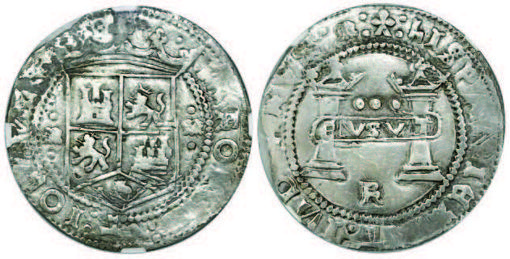
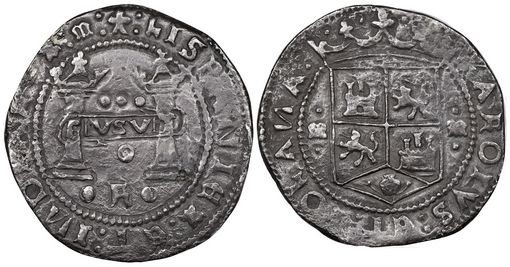
The bulk of the at least 40 known 3-reales coins are of the three-dots/no-water variety, nineteen of which belong to one type, the Nesmith 5c. Two other types contain nine coins (Nesmith 5b) and seven coins, respectively, and the rest are unique or almost unique types. It is evident that these coins were minted after the “water” series, given the greater use of crude or Latin lettering as the Gothic punches wore out. The Latin letter N in the legend is composed of two vertical lines and a slanted line that runs in either direction (normal N or retrograde N). This is common in other denominations under Assayer R as well. Why this is true of only the letter N is unknown and indicates a lack of a proper Latin N punch.
The fact that there were only a certain number of Gothic punches from which to create coins is illustrated by the letter M. The Gothic oMo-oMo on either side of the shield contained a smaller M than was needed to finish INDIARVM on the legend of the pillars side and thus the small Gothic M at the end of the word looks strange.
On the shield side of the coin, there are two die carryovers from the three-dots/with-water variety, Nesmith 5a and Nesmith 5b. There are seven legend varieties, ranging from all-Gothic to mostly crude or Latin lettering. The use of the rretrograde N appears in the later coins with the cruder lettering. The O punch (in IOHANA) must have been an early casualty of overuse because that’s the first letter to make the change from Gothic to non-Gothic,also as mentioned before a subcategory under study and to be published with more details at a later time is the sub-variety with three dots for denomination and no water and additionally with 3 dots/annulets surrounding the assayer variety, (supposedly applied after production), have surfaced in the last decade, two specimens are known.
On the pillars side, the same ornament used to make the crowns of the pillars—a sort of three-petaled shamrock—becomes the initial part of the legend on that side at 12 o’clock, replacing the cross potent that was used in the three-dots/with-water series. It disappears again in the three-bars variety that followed. The final M in INDIARVM in either Latin or Gothic (usually Gothic).
The banner that runs between the pillars always reads PLVSVLT unlike the three-dots/with-water variety which reads PLVSVL. The banner wraps in either direction with Nesmith 5a and 5b types running from high left to low right and 5c from low left to high right.
Three Bars for Denomination
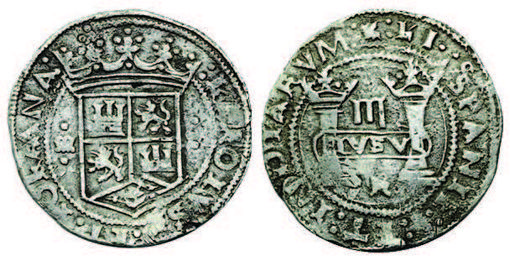
The greater use of non-Gothic lettering and crude execution place this coin variety in the last of the 3-reales coins minted before being replaced by 4-reales coins (which turned out to be much more suitable currency). The ornament at 12 o’clock in the pillars legend is now different from both of the earlier versions of 3 reales, what Nesmith called a punch 9 (or 10 when worn). We still do not have a name or description for this punch as it does not appear on any other Spanish coin, whether minted in Mexico City or elsewhere. It only appeared on Mexican coins under Assayer R.
The only three-bars variety that Nesmith catalogued, which he called 5d, is not illustrated by any other coin we have seen and thus all three-bars coins are hybrids of it. Since it is photographed in his book, we know it exists. As with the three-dots/with-water variety, there are few specimens to examine and most are unique. Of the nineteen examples, four are unique. Why the mint transitioned from three dots to three bars is unknown: however, “bars” for numbers can be found on coins minted during the reign of Ferdinand and Isabel. The bars resemble old Spanish accounting shorthand for Roman numerals, according to Daniel and Frank Sedwick in the 4th edition of The Practical Book of Cobs (pp. 27-28). In a perfect timeline, it would make more sense that three-dots varieties would follow three-bars varieties, but this is not the case. As with many aspect of this complicated series, we don’t usually know anything with certainty. Dots were used for denomination in 2 reales. By the time 4 reales were minted, the denomination was expressed as an Arabic 4.
The three-bars type always has the same PLVSVL in the banner running between and around the pillars, and the wrap direction of that banner is as the three-dots/non-water type: by this time, however, the L in the banner is crude rather than Gothic.
An important discovery is that there is a die-match with the three-bars shield side and the earliest of the 4-reales designs as illustrated below. In addition, the later three-bars coins have eleven rondules in the crown above the shield, while all others (and all three-dots/with-water and three-dots/no-water) have four rondules in the crown. Again, this is part of the design carryover from 3 reales to 4 reales.
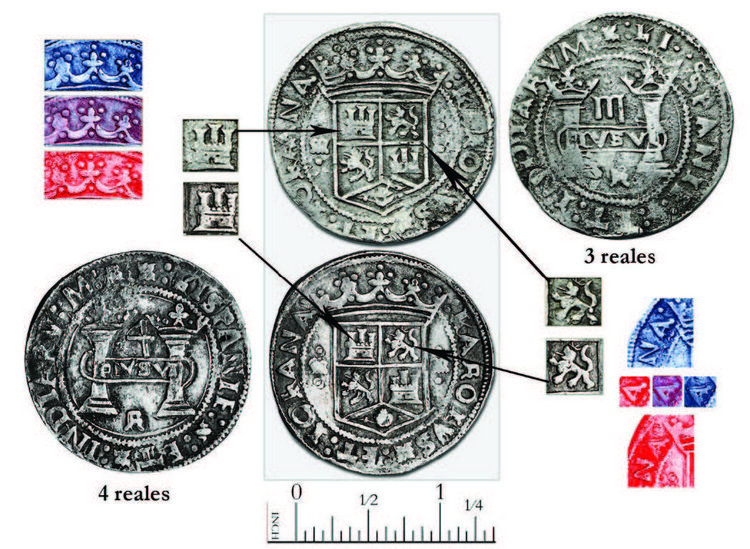
On the three-bars shield side, there is one die carryover from the three-dots/no-water variety, in addition to six other shield-side legend varieties( five are exclusive to four-rondule crowns, two are exclusive to eleven-rondule crowns, and one is found on coins with both types of crowns). Lions have tongues and crowns, and pomegranates have leaves.
There are two pillars-side legends which differ in the use of N or retrograde N in INDIARVM and a “:” inserted in INDIAR:VM. Many of the letters are crude, with H in HISPANIE bearing a diagonal slash to make it resemble a crude K.
Conclusions
The most important discovery from this research into the 3-reales varieties from the Mexico City mint is that there was a die overlap between 3- and 4-reales coins. Previously these were thought to be distinct entities. Now we know that, for some period of time, the mint produced 4-reales coins using a 3-reales shield-side die. While the coins are not the same size and weight, it was possible to do this since often the tops of the legend letters on 3-reales coins were cut off while the complete legend is discernible on the few 4-reales coins we can use for comparison.
Based on die details, we can state that there are three broad phases of coin production under Assayer R:
• 3, 2, 1, ½, ¼ reales were produced first,
• 4 reales were produced next,
• And the implementation of the rhomboid panel to replace the ribboned banner with some form of PLVS VLTRA (and limited production of 8 reales) was the final phase before the start of the next assayer’s tenure.
Within the family of 3-reales coins, there were three varieties: three dots for denomination and water under the pillars, three dots for denomination with no water under the pillars, and three bars for denomination with no water under the pillars. We have about twice as many examples of the second variety than either of the other two, and the first variety is exceedingly rare. But, who knows whether more varieties exist? And who knows whether there are more sub-varieties within each of these three? Perhaps if we ever see the 38 recorded 3-reales coins in “buena conservación” (well-preserved condition) from the Inés de Soto shipwreck we would be surprised. (Inés de Soto. P. 129) It is doubtful that any 3-reales coins with dots and water were found on the wreck, as none is illustrated nor mentioned in the description written by Alfredo Díaz Gámez. (Inés de Soto, p. 115).
